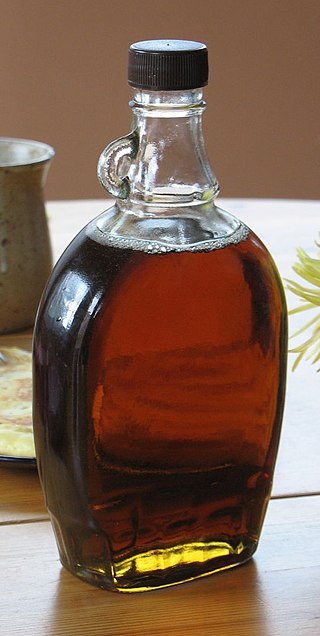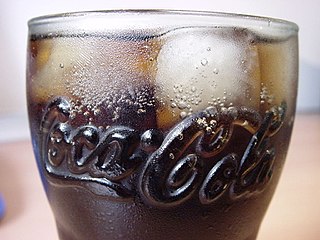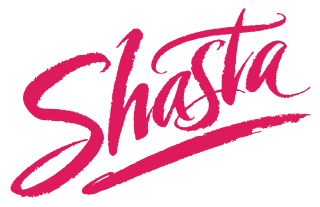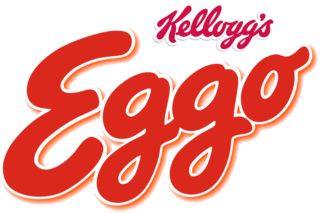Related Research Articles

Maple syrup is a syrup made from the sap of maple trees. In cold climates, these trees store starch in their trunks and roots before winter; the starch is then converted to sugar that rises in the sap in late winter and early spring. Maple trees are tapped by drilling holes into their trunks and collecting the sap, which is processed by heating to evaporate much of the water, leaving the concentrated syrup.
A sweetener is a substance added to food or drink to impart the flavor of sweetness, either because it contains a type of sugar, or because it contains a sweet-tasting sugar substitute. Various natural non-sugar sweeteners and artificial sweeteners are used to produce food and drink.

Corn syrup is a food syrup which is made from the starch of corn/maize and contains varying amounts of sugars: glucose, maltose and higher oligosaccharides, depending on the grade. Corn syrup is used in foods to soften texture, add volume, prevent crystallization of sugar, and enhance flavor. Most table syrups are typically based with corn syrup. It can be processed into high-fructose corn syrup (HFCS) by using the enzyme D-xylose isomerase to convert a large proportion of its glucose into sweeter fructose.

The Coca-Cola Company's formula for Coca-Cola syrup, which bottlers combine with carbonated water to create the company's flagship cola soft drink, is a closely guarded trade secret. Company founder Asa Candler initiated the veil of secrecy that surrounds the formula in 1891 as a publicity, marketing, and intellectual property protection strategy. While several recipes, each purporting to be the authentic formula, have been published, the company maintains that the actual formula remains a secret, known only to a very few select, and anonymous, employees. The claim that the recipe is only known to two people and that they cannot fly on the same plane due to the chance they may die, and the recipe will become unknown, is a myth and has been fact-checked multiple times.

In cooking, syrup is a condiment that is a thick, viscous liquid consisting primarily of a solution of sugar in water, containing a large amount of dissolved sugars but showing little tendency to deposit crystals. In its concentrated form, its consistency is similar to that of molasses. The viscosity arises from the multiple hydrogen bonds between the dissolved sugar, which has many hydroxyl (OH) groups.

Shasta Beverages is an American soft drink manufacturer that markets a value-priced soft drink line with a wide variety of soda flavors, as well as a few drink mixers, under the brand name Shasta. The company name is derived from Mount Shasta in northern California and the associated Shasta Springs.
Birch syrup is syrup made from birch sap, and produced in much the same way as maple syrup. However, it is seldom used for pancake or waffle syrup as it has a much stronger flavor profile, more often it is used as an ingredient paired with pork or salmon dishes in sauces, glazes, and dressings, and as a flavoring in ice cream, beer, wine, and soft drinks.

Chocolate sauce, sometimes called chocolate syrup, is a sweet, chocolate-flavored condiment. It is often used as a topping or dessert sauce for various desserts, such as ice cream, or mixed with milk to make chocolate milk or blended with milk and ice cream to make a chocolate milkshake. Chocolate sauce is sold in a variety of consistencies, ranging from a thin liquid that can be drizzled from a bottle to a thick sauce that needs to be spooned onto the dessert item.

High-fructose corn syrup (HFCS), also known as glucose–fructose, isoglucose and glucose–fructose syrup, is a sweetener made from corn starch. As in the production of conventional corn syrup, the starch is broken down into glucose by enzymes. To make HFCS, the corn syrup is further processed by D-xylose isomerase to convert some of its glucose into fructose. HFCS was first marketed in the early 1970s by the Clinton Corn Processing Company, together with the Japanese Agency of Industrial Science and Technology, where the enzyme was discovered in 1965.

Waffle Crisp is a breakfast cereal made by Post Consumer Brands, which contains maple syrup–flavored corn cereal bits in a waffle shape. It was first launched in 1996. In 2013, Post introduced a lower-priced version of the cereal, "Waffle Crunch", as part of their Good MOREnings line of budget cereals. According to customer service at Post Foods, Waffle Crisp was discontinued in August 2018.

Pinnacle Foods, Inc., is a packaged foods company headquartered in Parsippany, New Jersey, that specializes in shelf-stable and frozen foods. The company became a subsidiary of Conagra Brands on October 26, 2018.

Mrs. Butterworth's is an American brand of table syrups and pancake mixes owned by Conagra Brands. The syrups come in distinctive bottles shaped as the character "Mrs. Butterworth", represented in the form of a matronly woman. The syrup was introduced in 1961. In 1999, the original glass bottles began to be replaced with plastic. In 2009, the character was given the first name "Joy" following a contest held by the company.

Agave syrup, also known as maguey syrup or agave nectar, is a sweetener commercially produced from several species of agave, including Agave tequilana and Agave salmiana. Blue-agave syrup contains 56% fructose as a sugar providing sweetening properties.

Log Cabin is an American brand of pre-packaged table syrups owned by Conagra Brands.

Eggo Cereal is a multigrain breakfast cereal introduced in 2006 and reintroduced in 2019. It is manufactured by WK Kellogg Co, a spin-out of Kellogg's. It resembles Eggo waffles, a brand of frozen waffles produced by Kellanova and shares much of the same branding.
Flavored syrups typically consist of a simple syrup, that is sugar, with naturally occurring or artificial (synthesized) flavorings also dissolved in them. A sugar substitute may also be used.
Critics and competitors of high-fructose corn syrup (HFCS), notably the sugar industry, have for many years used various public relations campaigns to claim the sweetener causes certain health conditions, despite the lack of scientific evidence that HFCS differs nutritionally from sugar. The HFCS industry has tried to respond to these campaigns with their own efforts.

Pearl Milling Company is a North American brand for pancake mix, table syrup, and other breakfast food products. The original version of the pancake mix was developed in 1888–1889, and was advertised as the first "ready-mix" cooking product.
References
- ↑ Sendak, Paul E. (1978). "Consumer preference for graded maple syrup".
- ↑ "CFR - Code of Federal Regulations Title 21". www.accessdata.fda.gov. Retrieved 2023-04-07.
- 1 2 3 4 Appelbaum, Yoni (2011-11-01). "Making the Grade: Why the Cheapest Maple Syrup Tastes Best". The Atlantic. Retrieved 2023-04-07.
- ↑ Regier, C. C. (1933). "The Struggle for Federal Food and Drugs Legislation". Law and Contemporary Problems. 1 (1): 3–15. doi:10.2307/1189447. ISSN 0023-9186. JSTOR 1189447.
- 1 2 "Is Maple Syrup Good for You?". Consumer Reports. Retrieved 2023-04-07.
- ↑ Calvo, Trisha (25 March 2017). "5 Things You Need to Know About Maple Syrup". Consumer Reports. Archived from the original on 23 February 2017. Retrieved 21 May 2017.
- 1 2 3 "Why Americans overwhelmingly prefer fake maple syrup". Washington Post. ISSN 0190-8286 . Retrieved 2023-04-07.